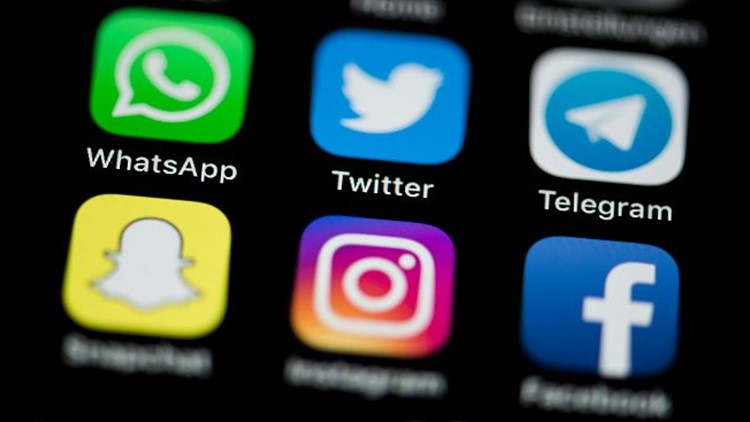The more teens check social media and stream video, the more likely they might develop symptoms of attention deficit hyperactivity disorder, a new study suggests.
The study, published in the medical journal JAMA on Tuesday, sheds light on how more research is needed to determine whether symptoms of the disorder, commonly called ADHD, are possibly caused by digital media use.
“If we can determine if there is a potential causal link that is consistent across studies, then we can design interventions to curb media exposure. Even simple educational information to let teachers, parents, and pediatric health professionals know that there could be an increased risk when they talk with their teens about digital media use might be helpful,” said Adam Leventhal, a licensed clinical psychologist and a professor of preventive medicine at the University of Southern California Keck School of Medicine, and lead author of the study.
ADHD symptoms include inattention, hyperactivity, restlessness or impulsivity that is more severe, frequent or debilitating than normal.
The disorder, which is more common in boys than girls, affects about 5% of all children in the United States, according to the US Centers for Disease Control and Prevention. The prevalence of ADHD has been estimated at 5% worldwide, as well.
Treatment options include behavior therapy, medication and school accommodations.
“ADHD’s been linked with substance use disorders during adulthood and even involvement in the criminal justice system, and the symptoms are distressing for the person affected,” Leventhal said. “If we can identify any potential risk factor that is implicated in this disorder then that’s important, especially ones that are modifiable like digital media use.”
‘The association … was persistent’
The new study involved 2,587 students in 10 high schools across Los Angeles County, California. The students, who had no significant symptoms of ADHD at the study’s start, were 15 to 16 years old.
The students participated in the study over a two-year period, beginning in fall 2014, with follow-up data collection in spring 2015, fall 2015, spring 2016, and fall 2016.
At each of those time points, the students completed a form that measured ADHD symptoms, including nine inattention symptoms and nine hyperactivity-impulsivity symptoms.
At the start of the study, the students completed surveys in which they reported how frequently they engaged in 14 digital media activities, such as social networking, texting, playing digital games, online shopping, video chatting, reading online content or streaming videos or music.
In each survey response, the students indicated whether their recent digital media use was high-frequency, meaning many times per day, or at other frequency levels, such as zero times a week, once or twice a week or once or twice a day.
After analyzing the self-reported symptoms and digital media survey responses, the researchers found that each additional high-frequency engagement in a digital media activity was associated with higher odds of having ADHD symptoms at each follow-up point.
The researchers found that, on average, 9.5% of the students who reported engaging in seven high-frequency digital media activities reported ADHD symptoms, and 10.5% of those who reported engaging in all 14 high-frequency digital media activities reported ADHD symptoms.
By comparison, only 4.6% of the students who reported not engaging in any of the digital media activities also reported ADHD symptoms throughout the study.
“Those percentages — like the 4.6% — reflect the average rates across the four different follow-ups,” Leventhal said. “So one of the things we noticed in the study was that the association between digital media and prevalence of ADHD symptoms was persistent across the entire follow-up period.”
The researchers described the association between higher frequency of digital media use and subsequent ADHD symptoms as “statistically significant but modest.”
The study had some limitations, including that only a specific age of students was included in the study and the students were based only in the Los Angeles area. More research is needed to determine whether similar findings would emerge among a more geographically diverse group of teenagers across a wider age range.
Also, the study only showed an association between modern digital media use and subsequent ADHD symptoms. More research is needed to determine whether that relationship is causal or reflects reverse causation. For instance, genetics or environmental influences may increase both ADHD symptoms and digital media access or use. Income and media use among parents also can influence media use among children.
The study also was based on self-reports of digital media use and ADHD symptoms.
“We didn’t have clinicians involved in our study to actually provide a diagnosis,” Leventhal said, but not everyone would call that a limitation.
‘The results must be understood as tentative’
Dr. Dimitri Christakis, a pediatrician and director of the Center for Childhood Health, Behavior, and Development at the Seattle Children’s Research Institute, called the study “the best to date” showing the association between digital media use and ADHD symptoms.
He said that looking at symptoms instead of diagnoses was one strength of the research.
“Even without a clinical diagnosis of ADHD, diminished attentional capacity is associated with poorer function both in childhood and in subsequent adulthood,” said Christakis, who was not involved in the research.
“We know that having a shorter attention span, regardless of whether or not you have a diagnosis of ADHD, is bad,” he said.
A shorter attention span, or distractibility, is a “cardinal feature of ADHD,” Christakis said.
With constant digital media use, “you can create a habit of mind where your brain is constantly seeking something more interesting, something more stimulating, because it’s always available — and that leads to distractibility,” he said. “The biggest problem children with ADHD have is, they’re easily distracted.”
The study was interesting, but there are three reasons to remain cautious, Andy Przybylski, an associate professor and director of research at the University of Oxford’s Oxford Internet Institute, said in a written statement released by the independent Science Media Centre on Tuesday.
“First, though the analyses are done well they demonstrate a very small correlation between digital media use and non-clinical measure of the ADHD symptoms. This means the study is a proof of concept that tells us we need very large samples when we design future studies because the possible effects are extremely small,” said Przybylski, who was not involved in the study.
“Second, the study doesn’t measure either digital media use or ADHD directly. For both the study relies on survey responses provided by the student in question. It is not clear if teachers or parents would rate the children similarly or if the self-reported measure of digital screen use is correlated with either actual behaviour or higher quality survey items,” he said. “Finally, because this was an exploratory study, instead of a registered or confirmatory study, the results must be understood as tentative.”
The digital media guidelines doctors recommend
Dr. Jenny Radesky, a developmental behavioral pediatrician and assistant professor at the University of Michigan Medical School in Ann Arbor, wrote an editorial accompanying the new study.
“With more timely digital media research, parents may feel more confident in the evidence underlying recommendations for how to manage the onslaught of media in their households,” Radesky wrote.
The results “affirm the 2016 American Academy of Pediatrics guidelines to prioritize activities that promote adolescent executive functioning and well-being, including sleep, physical activity, distraction-free homework, and positive interactions with family and friends,” wrote Radesky, who was a lead author of the academy’s guidelines for young children, along with Christakis.
For children 6 and older, the academy recommends placing consistent limits on the time spent using media, designating media-free times together such as at dinner or traveling, and having ongoing communication about online privacy and safety, among other suggestions.
Radesky wrote in her editorial that “although not directly addressed by this study, the American Academy of Pediatrics recommendations for parent involvement in their adolescent’s media use — including discussions about prosocial uses of media, digital citizenship, misinformation, and persuasion awareness — are relevant to the cognitive and emotional reactions to digital media of adolescents.”



